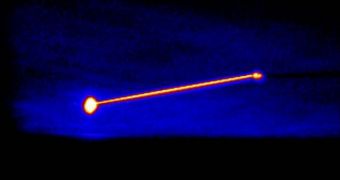Officials with the US Missile Defense Agency (MDA) believe that laser systems mounted on aircraft represent the future of safeguarding the nation against incoming missiles. But such a system has recently had its third flight test delayed due to technical issues.
The Airborne Laser is a device mounted in a heavily-modified Boeing 747, and which is capable of zapping dangerous missiles with high-energy lasers in mid-flight.
In test flights conducted earlier this year, the airplane and its weapon proved that they can work very well together. In those instances the AL functioned flawlessly as a whole.
But now, a malfunction in the airplane's cooling system prompted MDA experts to delay the third test flight the AL was supposed to perform.
The defense system is currently being tested at the Edwards Air Force Base (EAFB), in California.
According to the director of the MDA, Army Lt. Gen. Patrick O'Reilly, the agency is targeting today, August 21, as a potential date for the third AL test flight. He made the announcement this Tuesday.
Earlier this year, in February, the Airborne Laser was tested for the first time. At the time, experts managed to calibrate the system so that it could destroy a boosting sounding rocket.
In the second test, the plane and its laser had to destroy threat-representative target missile. Though it completed this task successfully, it failed to hit a secondary target immediately afterwards.
According to the MDA, the new flights were supposed to see the AL targeting threats from twice the distance it engaged them from in the first two tests.
The agency is not disclosing the actual ranges, because they are classified. The data will only be made available to military personnel and high-ranking officials.
The entire Airborne Laser system is a collaboration of the largest defense and space contractors in the United States, and indeed the world.
Denver-based Lockheed Martin constructed and developed the beam control systems, which control the firing sequence of the AL, Space reports.
St. Louis-based Boeing Defense, Space & Security acts as the prime contractor for the project, while Los Angeles-based Northrop Grumman Aerospace Systems is in charge of developing the chemical laser that powers the airplane.

 14 DAY TRIAL //
14 DAY TRIAL //